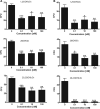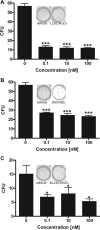Novel vitamin D hydroxyderivatives inhibit melanoma growth and show differential effects on normal melanocytes
- PMID: 22993313
- PMCID: PMC3458587
Novel vitamin D hydroxyderivatives inhibit melanoma growth and show differential effects on normal melanocytes
Abstract
Background/aims: To test the activity of novel hydroxyvitamin D(3) analogs (20(OH)D(3), 20,23(OH)(2)D and 1,20(OH)(2)D(3)) on normal and malignant melanocytes in comparison to 1,25(OH)(2)D(3).
Materials and methods: Human epidermal melanocytes and human and hamster melanoma cells were used to measure effects on proliferation and colony formation in monolayer and soft agar. Cell morphology and melanogenesis were also analyzed. QPCR was used to measure gene expression.
Results: Novel secosteroids inhibited proliferation and colony formation by melanoma cells in a similar fashion to 1,25(OH)(2)D(3), having no effect on melanogenesis. These effects were accompanied by ligand-induced translocation of VDR to the nucleus. In normal melanocytes 1α-hydroxyderivatives (1,25(OH)(2)D(3) and 1,20(OH)(2)D(3)) had stronger anti-proliferative effects than 20(OH)D(3) and 20,23(OH)(2)D(3), and inhibited dendrite formation. The cells tested expressed genes encoding VDR and enzymes that activate or inactivate vitamin D(3).
Conclusion: Novel secosteroids show potent anti-melanoma activity in vitro with 20(OH)D(3) and 20,23(OH)(2)D(3) being excellent candidates for pre-clinical testing.
Figures







Similar articles
-
Antitumor effects of vitamin D analogs on hamster and mouse melanoma cell lines in relation to melanin pigmentation.Int J Mol Sci. 2015 Mar 24;16(4):6645-67. doi: 10.3390/ijms16046645. Int J Mol Sci. 2015. PMID: 25811927 Free PMC article.
-
Signature of VDR miRNAs and epigenetic modulation of vitamin D signaling in melanoma cell lines.Anticancer Res. 2012 Jan;32(1):383-9. Anticancer Res. 2012. PMID: 22213330
-
Antiproliferative activity of side-chain truncated vitamin D analogs (PRI-1203 and PRI-1204) against human malignant melanoma cell lines.Eur J Pharmacol. 2020 Aug 15;881:173170. doi: 10.1016/j.ejphar.2020.173170. Epub 2020 May 20. Eur J Pharmacol. 2020. PMID: 32445704
-
On the role of classical and novel forms of vitamin D in melanoma progression and management.J Steroid Biochem Mol Biol. 2018 Mar;177:159-170. doi: 10.1016/j.jsbmb.2017.06.013. Epub 2017 Jul 1. J Steroid Biochem Mol Biol. 2018. PMID: 28676457 Free PMC article. Review.
-
Vitamin D and systemic cancer: is this relevant to malignant melanoma?Br J Dermatol. 2002 Aug;147(2):197-213. doi: 10.1046/j.1365-2133.2002.04960.x. Br J Dermatol. 2002. PMID: 12174089 Review.
Cited by
-
Chemical synthesis, biological activities and action on nuclear receptors of 20S(OH)D3, 20S,25(OH)2D3, 20S,23S(OH)2D3 and 20S,23R(OH)2D3.Bioorg Chem. 2022 Apr;121:105660. doi: 10.1016/j.bioorg.2022.105660. Epub 2022 Feb 8. Bioorg Chem. 2022. PMID: 35168121 Free PMC article.
-
Investigation of 20S-hydroxyvitamin D3 analogs and their 1α-OH derivatives as potent vitamin D receptor agonists with anti-inflammatory activities.Sci Rep. 2018 Jan 24;8(1):1478. doi: 10.1038/s41598-018-19183-7. Sci Rep. 2018. PMID: 29367669 Free PMC article.
-
Total synthesis of biologically active 20S-hydroxyvitamin D3.Steroids. 2015 Dec;104:153-62. doi: 10.1016/j.steroids.2015.09.009. Epub 2015 Oct 1. Steroids. 2015. PMID: 26433048 Free PMC article.
-
Detection of novel CYP11A1-derived secosteroids in the human epidermis and serum and pig adrenal gland.Sci Rep. 2015 Oct 8;5:14875. doi: 10.1038/srep14875. Sci Rep. 2015. PMID: 26445902 Free PMC article.
-
Vitamin D Signaling in Psoriasis: Pathogenesis and Therapy.Int J Mol Sci. 2022 Aug 2;23(15):8575. doi: 10.3390/ijms23158575. Int J Mol Sci. 2022. PMID: 35955731 Free PMC article. Review.
References
-
- Carlberg C, Molnar F. Current status of vitamin D signaling and its therapeutic applications. Curr Top Med Chem. 2012;12:528–547. - PubMed
-
- Colston K, Colston MJ, Feldman D. 1,25-dihydroxyvitamin D3 and malignant melanoma: the presence of receptors and inhibition of cell growth in culture. Endocrinology. 1981;108:1083–1086. - PubMed
Publication types
MeSH terms
Substances
Grants and funding
LinkOut - more resources
Full Text Sources
Medical
